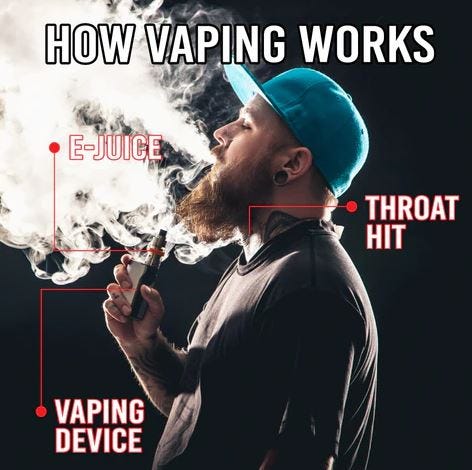RandM Tornado 7000 Review (All Flavours in Stock)



The controversy about vaping and its effectiveness as a smoking cessation strategy has raged for years, igniting debate among healthcare experts, lawmakers, and the general public. While some promote vaping as a viable replacement for traditional smoking, others are cautious, citing long-term health issues and potential hazards. In this extensive review, we will examine the facts, arguments, and controversies surrounding whether vaping may help individuals quit smoking.
Understanding Quitting Smoking:
Smoking continues to be one of the major causes of preventable mortality globally, contributing to a variety of health issues including cancer, heart disease, and respiratory disorders. Despite widespread knowledge of its negative consequences, many smokers struggle to stop due to nicotine addiction, habituation, and social factors. Traditional smoking cessation approaches, such as nicotine replacement therapy (NRT) and counselling, have had different degrees of effectiveness, but they frequently fall short of long-term sobriety.
The Rise of Vaping:

Enter vaping, is a relatively new phenomenon that gained popularity in the early 2000s as a substitute for traditional smoking. Vaping is the process of inhaling and exhaling an aerosol created by electronic cigarettes or vape pens, which often include nicotine, flavourings, and other substances. Proponents of vaping believe that it is a safer alternative to smoking because it exposes you to less hazardous chemicals than tobacco smoke.
Evidence in Support of Vaping as a Smoking Cessation Aid:
Nicotine Replacement: Vaping devices supply nicotine in a similar way to regular cigarettes, giving smokers a nicotine source without the dangerous toxins produced during combustion. The nicotine replacement treatment part of vaping may help relieve withdrawal symptoms and cravings, easing the move away from traditional smoking.
Behavioural Substitution: Vaping replicates smoking behaviours, such as hand-to-mouth motion and vapour inhalation, which may satisfy smokers’ psychological desires and routines. Vaping may be a helpful technique for moving away from traditional cigarettes since it replicates familiar smoking routines without the associated risks of combustion.
Flexible nicotine levels: Vaping devices allow users to change nicotine levels based on their tastes, providing a personalized approach to quitting smoking. Smokers can progressively reduce their nicotine consumption over time, eventually weaning themselves off dependence and achieving cessation.

Anecdotal reports: Many former smokers credit vaping for their successful stop attempts, citing decreased cravings, increased lung function, and overall better health outcomes. While anecdotal evidence is inconclusive, it does emphasize vaping’s potential as a smoking cessation assistance for certain individuals.
Critiques and Challenges:
Despite the potential benefits, vaping as a smoking cessation strategy is not without its detractors and difficulties. Sceptics have various worries about the safety, efficacy, and ethical implications of advocating vaping for smoking cessation.
Long-term health effects: The long-term health repercussions of vaping continue to be studied and debated. While vaping is generally thought to be less toxic than smoking since there is no combustion, there are still worries about the risks of breathing aerosolized chemicals and additives present in vaping products.
Gateway To Smoking: Critics say that vaping may lead to traditional smoking, particularly among young people and non-smokers. The availability of flavoured e-cigarettes, along with strong marketing strategies by industry operators, has prompted concerns about renormalizing smoking practices and undermining tobacco control efforts.
Dual Usage: Some people may participate in dual usage, vaping while also smoking regular cigarettes, undermining the goal of smoking cessation. Dual users may endure ongoing nicotine dependence and face difficulties shifting completely to vaping or establishing abstinence from both smoking and vaping.
Regulation Challenges: The continuously changing landscape of vaping goods presents issues for regulatory authorities charged with monitoring and regulating the business. The absence of defined production procedures, unpredictable product quality, and aggressive marketing strategies exacerbate efforts to safeguard consumer safety and public health.
Social stigma: Despite its potential as a smoking cessation tool, vaping faces social stigma and public scrutiny. Negative attitudes toward vaping, fostered by media depictions and misconceptions, may dissuade smokers from considering it as a viable option to traditional smoking.
Conclusion:
If you want to get rid of your nicotine addiction, the best way is to quit cold turkey. There are numerous methodical approaches to accomplish this, such as reducing your daily cigarette consumption.
If quitting cold turkey sounds too difficult for you, you can utilize the weaning strategy to gradually reduce your nicotine intake.
If you’ve tried quitting nicotine and want to replace your smoking habits, vaping could be a suitable fit for you.
The decision is yours, and if you decide to begin your vaping journey, educating yourself on the vaping lifestyle can help you make a smooth transition. Best of luck and don’t give up!
If you already vape, please share your experience with us so that we can help other smokers! Any tips or advice would be really helpful!
Comments
Post a Comment